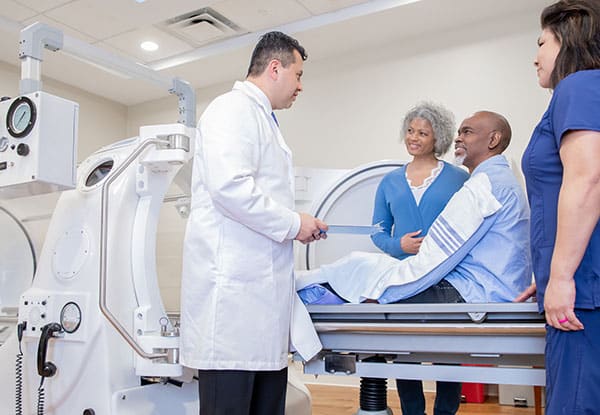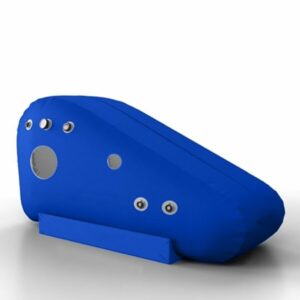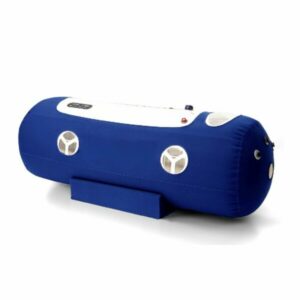Exposure to hyperbaric oxygen therapy can benefit your patient. However, the risk factors cannot be downplayed. Discover its safety and risks and decide whether it’s best for your patient.
Hyperbaric Chamber Therapy, also known as Hyperbaric Oxygen Therapy (HBOT), is a treatment that requires patients to breathe in 100% pure oxygen while in a pressurized chamber. The increased pressure helps deliver more oxygen to the body’s tissues, promoting healing and treating various medical conditions. However, like any medical treatment, risks, and potential complications should be considered before undergoing HBOT.
Hyperbaric chamber therapy, or hyperbaric oxygen therapy, is a medical treatment that has been around for over a century. It involves using a specialized chamber that is pressurized to allow the patient to take in pure oxygen. However, as a healthcare practitioner, discussing this treatment’s pros, cons, and risks is necessary to ascertain its safety for your client. Let’s dive further!
The increased pressure and oxygen levels in the chamber can promote healing and provide therapeutic benefits for various medical conditions. This explains the case with Oxygenark Hyperbaric Chamber which is indicated to treat carbon monoxide poisoning and wounds that are slow to heal, such as those caused by diabetes or radiation therapy. It can also treat certain infections, such as those caused by anaerobic bacteria.
While hyperbaric chamber therapy is generally considered safe, there are some risks and potential drawbacks associated with the treatment. For example, some patients may experience ear pain, sinus pressure, or changes in vision during the treatment. Additionally, oxygen toxicity is risky if the treatment is not administered correctly.
With proper administration and supervision, hyperbaric chamber therapy can provide significant benefits and help patients achieve better health outcomes.
Middle ear injury is one of the most common risks associated with hyperbaric chamber therapy, caused by pressure changes in the ears. When a patient enters the hyperbaric chamber, the pressure inside the chamber is increased to create an environment that allows for the intake of higher levels of oxygen. As the pressure in the chamber increases, it can cause pressure changes in the ears, leading to injury.
Patients with a history of ear infections or ear surgery are at higher risk for middle ear injuries. However, they may need to take additional precautions or be closely monitored during the treatment.
One of the most significant risks associated with hyperbaric chamber therapy is oxygen toxicity, which can lead to lung injuries. Oxygen toxicity occurs when the body is exposed to high oxygen levels for an extended period, leading to oxidative stress and lung inflammation. This can cause damage to the lung tissue and lead to symptoms such as shortness of breath, chest pain, and coughing.
The risk of oxygen toxicity increases when a patient receives hyperbaric chamber therapy at high pressures or for an extended period. Patients with pre-existing lung conditions or smokers may also be at increased risk of developing lung injuries from hyperbaric chamber therapy.
Exposure to hyperbaric oxygen therapy causes changes in eye pressure that can lead to eye injuries. The increased pressure inside the hyperbaric chamber can affect the fluid in the eye and lead to a range of eye symptoms, such as eye pain, blurred vision, and even blindness.
Although, the risk of eye injuries during hyperbaric chamber therapy is generally low, and the majority of patients do not experience any adverse effects. However, during hyperbaric chamber therapy, patients with pre-existing eye conditions or those who have undergone eye surgery may be at increased risk for eye injuries.
Despite these potential complications, hyperbaric chamber therapy is generally well-tolerated by most patients. Many patients report feeling relaxed and rejuvenated after a session in the chamber. Some patients may even experience an improvement in mood or overall well-being.
Despite these risks, Oxygenark hyperbaric chamber therapy remains a valuable and effective treatment option for many medical conditions. Its non-invasive nature and lack of significant side effects make it an attractive choice for patients looking to avoid more invasive treatments.
Hyperbaric chamber therapy has been used for many years to treat various medical conditions. The therapy is generally considered safe, with infrequent complications, and it’s well-tolerated by most patients. However, like any medical treatment, there are some risks and potential drawbacks associated with hyperbaric chamber therapy.
As a healthcare provider, discuss the risks and benefits of this treatment with your patients before starting, and ensure that the patient is fit for the hyperbaric chamber therapy and that the potential risks are minimized.
In many cases, hyperbaric chamber therapy can be a valuable treatment option for patients who have not responded to other treatments or are looking for a non-invasive and safe alternative to traditional treatments.

Doctor assisting patient with hyperbaric chamber in wound care center at hospital
People who recently underwent dental or ear surgery (or injury) or with some types of lung diseases should stay off HBOT. Also, those with a history of the collapsed lung may encounter severe side effects from hyperbaric chamber treatment. Therefore, they should not go for HBOT.
In addition, all facilities must be scrutinized and certified by the Hyperbaric Medical Society and the Undersea before commencing treatment.
HBOT is generally safe when used appropriately and under the guidance of a medical professional. However, it is crucial to consider the potential risks and to discuss any concerns with a healthcare provider before undergoing treatment.
The most common complication of HBOT is ear barotrauma, caused by changes in pressure within the chamber. This can result in pain, dizziness, or even a ruptured eardrum. However, this complication is usually mild and can be managed with proper techniques, such as equalizing ear pressure.
In some cases, hyperbaric oxygen therapy can be harmful, especially for people with certain medical conditions. For example, HBOT can increase the risk of seizures in people with a history of seizures or those with certain neurological disorders. Additionally, people with certain types of lung disease may experience lung damage from the high oxygen levels used during HBOT.

The risks of HBOT can include ear barotrauma, lung damage, seizures, and other potential complications. These risks should be weighed against the potential benefits of the therapy for each case.
This is one of the most common risks of HBOT, caused by changes in air pressure during the treatment. Patients may experience discomfort or pain in their ears, ringing, or temporary hearing loss. In rare cases, ear barotrauma may lead to permanent hearing loss.
Damage to the lungs can occur if a patient has a pre-existing lung condition or breathes in too much pure oxygen during the treatment. This can lead to oxygen toxicity, leading to inflammation and lung damage.
Seizures are complications of HBOT, particularly in patients with a history of seizures or neurological conditions. Other potential risks of HBOT include changes in vision, claustrophobia, and allergic reactions to the materials used in the treatment.
Despite these potential risks, it is important to note that HBOT is generally considered safe when performed by a trained healthcare professional. The dangers of the treatment should be weighed against the potential benefits of each case.
While HBOT is generally considered safe, knowing the potential risks and complications associated with the treatment is important. Patients should discuss concerns or questions with their healthcare provider before HBOT.

The benefits of HBOT are huge; however, there are also potential risks and limitations to consider, such as the cost of treatment, the need for multiple sessions, and the potential for complications.
While the treatment has potential benefits, it is essential to consider the ad and cons before deciding if it is the right option.
This can include improved healing for certain medical conditions, such as wounds, burns, and radiation injuries.
There are also potential drawbacks to consider regarding HBOT.
There are also potential risks and complications associated with HBOT. As mentioned previously, ear barotrauma, lung damage, and seizures are all potential risks of the treatment. In rare cases, HBOT may also lead to oxygen toxicity or other serious complications.
The decision to undergo HBOT should be made after considering both the potential benefits and drawbacks of the treatment. While it may be a valuable option for certain medical conditions, discussing any concerns or questions with a healthcare professional to determine if it is the right option for you is important.
HBOT is generally safe for most people, but certain individuals should avoid using a hyperbaric chamber. These include people with;
In addition to those who should avoid using a hyperbaric chamber, certain individuals are not candidates for HBOT. These include people with a history of certain types of cancer and those with an active infection or taking certain medications.
Hyperbaric Chamber Therapy can be a useful treatment option for various medical conditions, but it is important to understand the risks and benefits before undergoing treatment. According to their medical history, patients should speak with their healthcare provider to determine if HBOT is appropriate for them.
Our product – The oxygenark hyperbaric chamber, has the best component and is made with the highest standards. The equipment is also manufactured with the highest safety requirement, making it a must-have in every hospital environment.
Get in touch with us and unlock your full well-being potential!
The OxygenArk team is here to assist you every step of the way.